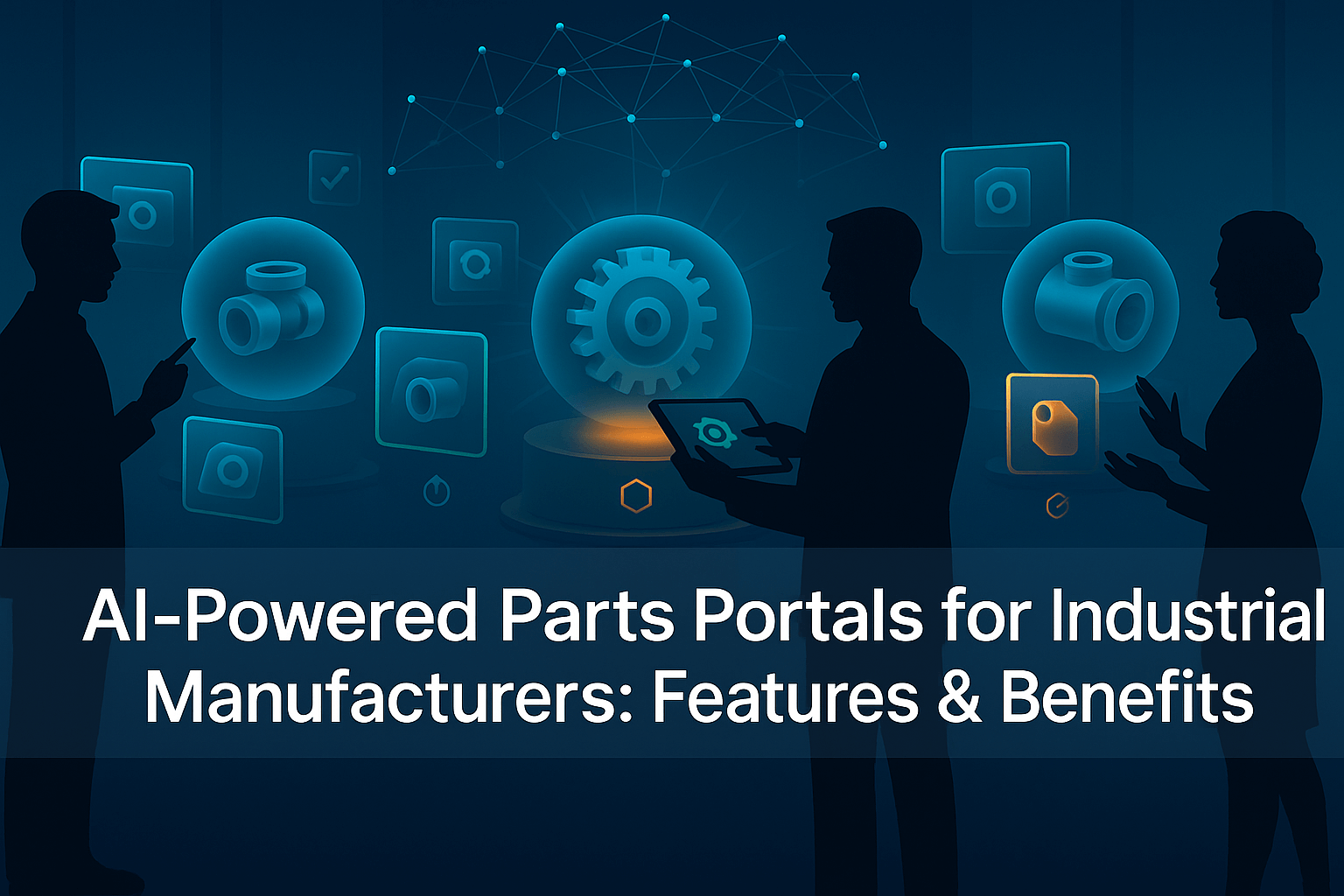The Untapped Margin Sitting in Your Parts Business
If you run an industrial manufacturing or distribution business, you already know your aftermarket parts division has the potential to be a quiet profit engine in today’s competitive industry landscape. The margins are healthier than on new equipment, the buyer is often already loyal, and the cost to serve them should be minimal.
But here’s the reality: in many organizations, the aftermarket isn’t a profit engine—it’s a profit leak. Not because the demand isn’t there, but because the path to buying is clogged with friction.
Domestic buyers get stuck on hold with your parts desk. Export buyers are trapped in a separate catalog with outdated SKUs. Time zones turn a 20-minute task into a 48-hour delay. And because your team is fielding endless “Do you have this in stock?” calls, they have less time to nurture bigger opportunities.
The irony is that the parts customers—the ones who already trust you and are part of your long-standing community—are often the ones who leave first. Not out of dissatisfaction with the products, but a competitor’s website could answer one serial-number query faster than your team could return a call. You don’t lose the sale in a heated price battle; you lose it in silence, while the buyer quietly clicks “order” somewhere else.
Every one of those lost moments is a margin point gone. And because they disappear into the noise of daily operations, they never make it onto a spreadsheet for your board meeting. Which means the loss continues—quietly, invisibly—until someone decides to tear the process apart and rebuild it for the way your customers will buy in the future.
That’s what an AI-powered, self-serve parts portal does. Not just “make it easier to order,” but pull those hidden, repeatable dollars back into your business—without adding headcount or sacrificing control.
Complexity Isn’t the Problem — Manual Processes Are
Industrial parts catalogs are supposed to be complex. They have to be, because the equipment you make or distribute is complex. A hydraulic pump for a mining truck isn’t the same as one for a shipping crane. A gearbox that works perfectly in a humid coastal environment might seize in the dry heat of an inland desert. The variations exist for a reason—and your customers depend on that precision.
The problem isn’t the complexity itself. It’s that most manufacturers still ask humans—sales reps, customer service teams, even engineers—to untangle that complexity on demand, one phone call or email at a time. It’s a system that worked decades ago when order volumes were smaller and buyer expectations were different, but today it fails to support the speed and precision buyers demand. But today, it’s a bottleneck that bleeds time and erodes trust.
Manual processes introduce lag at every stage. A buyer sends a request. A rep forwards it to someone in engineering. Engineering digs through CAD drawings or ERP data to confirm compatibility. By the time the quote comes back, the buyer’s urgency has faded—or worse, they’ve already found an alternative supplier who could answer in minutes.
And it’s not just speed you’re losing. Every hand-off is another chance for an error to creep in, a mistyped part number, an outdated spec sheet, or a misread drawing. In a global market where a single mis-shipment can cost thousands in freight and weeks in delivery time, those errors are unforgivable.
What AI-powered portals change is the flow. Instead of making the customer wait for your team to decode the part puzzle, the system does it in real time, filtering, validating, and narrowing options the moment they enter a serial number or upload a BOM. It’s not replacing your team’s expertise; it’s scaling it, making it instantly available to every buyer, at any hour, anywhere in the world.
That shift—from manual to automated, from reactive to self-serve—isn’t just a technical upgrade. It tells your buyers, “We value your time as much as you do,” and it tells your team, “Your expertise should grow the business, not babysit the same repetitive questions over and over.”
The AI Shift — More Than Just Another Search Bar
Most “parts search” tools in the industrial world are exactly what the name suggests: a box that searches for text. Type a part number or description, hit enter, and get a list of results. That’s fine if your catalog is simple and your buyers already know exactly what they need.
But when your catalog runs into the tens or hundreds of thousands of SKUs and when many of those SKUs are technically similar but functionally incompatible, basic search stops being a solution and starts being a liability. It delivers everything that matches the query, leaving the buyer to do the sorting, filtering, and validating on their own. That’s not service. That’s passing the problem back to them.
An AI-powered parts portal changes the dynamic entirely. When a buyer enters a serial number, the system doesn’t just pull up “matching” parts; it pulls up the part that was originally shipped with that equipment, plus any updated, compatible replacements or upgrades. If a component has been discontinued, the AI doesn’t just say “no results”; instead, it suggests the right alternative, explains why, and updates the associated pricing, lead times, and documentation instantly.
It’s not just smarter search—it’s guided decision-making that expands your buyers’ capabilities to find the right part the first time. The AI can cross-reference equipment history, match regional compliance requirements, and even consider the buyer’s order history to make the recommendation more relevant.
And because the system connects to your ERP and inventory in real time, the information isn’t theoretical. The buyer isn’t seeing “usually ships in 5–7 days” based on last year’s data; they’re seeing exactly what’s in stock now, where it’s located, and when it can get to them.
It creates a buying experience that feels effortless to the customer but under the hood is quietly running dozens of validations and logic checks—removing the need for human intervention in 90% of cases and freeing your sales team to focus on the complex, high-value orders that truly require their expertise.
Designing the Portal UX Around Real-World Buyer Behavior
An AI-powered portal isn’t just about smart search; it’s also about guiding buyers through the exact steps they need to take without them even realizing they’re being guided. This means building the user experience (UX) from the buyer’s perspective, not from the catalog’s structure.
For industrial manufacturers, there are two main buyer archetypes you have to design for:
The Precision Buyer — usually a maintenance engineer or procurement specialist who already knows the exact part number, specs, or serial number. They want speed above all else.
The Problem Solver — someone who knows the equipment model, the symptoms, or the application, but not the exact SKU. They want guidance and reassurance.
Your portal has to serve both without making either feel like they’re using the “wrong” tool.
Serial-Number Lookup as the Starting Point
For precision buyers, serial-number lookup is the closest thing to magic. They type in the number stamped on the machine and instantly see the exact part, its compatible replacements, and whether it’s in stock. The beauty of this feature is that it eliminates the “filter fatigue” that plagues large catalogs—there’s no scrolling through dozens of near-misses or outdated SKUs.
For problem solvers, that same serial-number entry can trigger an intelligent tree of follow-up questions: “Is this part being replaced for maintenance or an upgrade?” “Is the equipment located in a hazardous environment?” Each answer quietly narrows the options without making the buyer feel like they’re taking a quiz.
Klevu Search for Natural Language Queries
While serial numbers are the precision tool, Klevu search is the conversational one. Klevu’s AI doesn’t just match keywords—it interprets intent. A buyer can type “replacement hose for Model X in high-temp environment,” and Klevu surfaces the correct item, even if the words “replacement” or “high-temp” aren’t in the product title. It learns from past behavior, meaning your most searched parts rise to the top faster over time.
And here’s the game-changer: you can train Klevu on your own historical orders and engineering data. That means it doesn’t just “guess” what buyers mean—it pulls from patterns you’ve already validated in the field.
Serving Domestic and Export Buyers in One UX
One of the biggest operational headaches for global parts sales is trying to serve domestic and export buyers without running two separate systems. An AI-powered portal solves this by applying rules in the background based on buyer location, account type, and contractual terms.
The same SKU might be available in the U.S. but restricted in the EU because of compliance. Or it might ship from one warehouse domestically but from a third-party distributor overseas. The buyer doesn’t need to know why—they just see the right price, lead time, and availability for them.
This unified approach eliminates the old “domestic site vs. export site” problem, which is not only frustrating for customers but also expensive for you to maintain. Now, it’s one portal, one interface, smart enough to shape itself to the buyer in real time.
Integrating Real-Time Inventory, Pricing, and Compliance
A slick UX means nothing if the information behind it is stale. In industrial parts sales, outdated data isn’t just inconvenient; it’s dangerous. If your portal shows a replacement module as “in stock” when it’s already been allocated to another order, you’ve just promised a delivery date you can’t hit. If you quote a price based on last quarter’s supplier cost, you could be eating into margin without realizing it.
The backbone of an AI-powered parts portal is its ability to pull live data from the systems that already run your business—ERP, warehouse management, PLM, compliance databases—and present that truth instantly to the buyer.
Inventory That’s Actually in Real Time
Static inventory syncs—say, once every night—are fine for low-volume retail. In industrial sales, where certain high-value parts can sell out in hours, they’re a liability. Your portal needs API-level connections to your ERP or WMS so inventory updates happen as they happen.
This also means multi-location warehouse awareness. If the main U.S. warehouse is out of stock, but a smaller location in Germany has inventory, the system can route the order there automatically—or show the buyer the choice, along with adjusted lead times and shipping costs.
Dynamic Pricing That Reflects the Real World
In B2B manufacturing, pricing isn’t static—it’s shaped by contract terms, regional adjustments, raw material fluctuations, and even currency shifts for export buyers. That’s why the pricing engine in your portal needs to pull live from your CPQ or ERP, not a flat price list.
For some clients, the portal can even calculate volume discounts or bundle pricing on the fly. If a buyer adds three related components to their cart, the system recognizes it as a set and applies the correct price tier—without manual review.
Compliance as an Invisible Gatekeeper
Compliance is where a lot of portals fail because they’re not enforced until after the order is placed. With the right integration, compliance checks become invisible to the buyer but absolute in enforcement.
If a component can’t legally ship to a certain country, it won’t even appear as an option for a buyer in that region. If an upgrade kit requires a specific certification for installation, the portal can prompt the buyer for that documentation before allowing checkout.
The buyer sees a smooth, personalized journey. Behind the scenes, your AI-powered portal is cross-referencing every click against inventory, pricing, and compliance rules in real time—meaning no one on your team has to clean up messes later.
The Four-Week Design Sprint — Building Proof Before You Bet Big
When you’re running a manufacturing business, the gamble isn’t whether a parts portal could work. The gamble is spending the better part of a year building it without knowing if the numbers will justify the spend. That’s why the smartest move isn’t a 12-month marathon—it’s a four-week sprint that ends with something real in your hands.
Not a slideshow. Not a “concept document.” A working prototype you can click through, break, test, and even put in front of the handful of customers you trust to give it to you straight.
Week 1 — Listen First, Then Map the Truth
The first week is about shutting up and listening. Talking to the people who actually know your buyers—the sales reps who field every request, the service managers who put out fires, and sometimes even the buyers themselves.
The goal is to trace every step, every frustration, every workaround a customer uses to find and receive a part—whether they’re down the street or halfway across the world.
Only then do we dig into your systems—ERP, WMS, CRM, CPQ, compliance databases—and see how they really talk to each other (or don’t).
Week 2 — Draw the Experience Before You Build It
Once the path is mapped, the second week turns it into something visible. Wireframes that show, click by click, how a buyer moves from “I need this part” to “order confirmed.”
This isn’t just boxes on a screen—it’s about designing the flow so things that feel complicated now (serial-number lookups, compliance checks, AI search) become invisible to the person using them.
Week 3 — Make It Breathe
Here’s where the static drawings start acting like a real portal. Feed in a limited slice of your actual data—live or staged—so it responds instantly.
AI search gets trained on your own history: orders, engineering data, and everything that can make it faster and more accurate than the way things work today.
Week 4 — Put It to the Test
The last week is where theory meets reality. A closed pilot with your own team and a small, trusted circle of customers. Every click is measured: how long it takes to find a part, to check out, and how many mistakes get avoided.
Then we put those numbers side by side with how things work now—so you can see, in hard data, the gap in efficiency, conversion, and order value.
By the end of those four weeks, you’re not making a decision on faith. You’re holding a living, clickable model of your parts portal—backed by numbers that show exactly what it could do for repeat orders, average order value, and the bottom line.
Features That Drive Revenue — And How They Show Up on the Bottom Line
Serial-Number Lookup That Eliminates Guesswork
One of the fastest ways to earn a buyer’s trust is to make ordering foolproof. With serial-number lookup, a buyer doesn’t have to guess part names, flip through outdated PDFs, or call customer service. They type in the number stamped on their equipment, and the portal instantly returns only compatible parts, upgrade kits, or replacements.
This reduces ordering time and nearly wipes out the most expensive kind of mistake—the wrong part shipped to the wrong job. When customers know they can get it right the first time, they order more confidently, more often, and with less hesitation.
AI Search That Understands Buyer Intent
Industrial buyers rarely type in perfect SKUs. More often, they’ll write something like “gasket for 2018 pump model” or “replacement hydraulic pump for Model X.” Standard search engines choke on those queries.
Klevu’s AI-powered search interprets intent, not just keywords. It surfaces the right parts even when the language isn’t exact. That kind of search experience keeps buyers moving forward instead of bouncing to a competitor’s site, enhancing productivity by reducing the back-and-forth clarifications that slow teams down. It also tends to grow each order’s value—because once a buyer sees how easy it is to find what they need, they’re more likely to explore and add related products.
Account-Specific Catalogs for Precision Selling
Not all buyers should see the same inventory. Export buyers face different compliance rules, domestic customers have unique contract pricing, and certain distributors can have exclusives. With account-specific catalogs, each buyer sees exactly what’s available to them—no false promises, no awkward “we can’t sell you that” calls after checkout.
It’s a small UX detail to give buyers a smoother experience that keeps buyers coming back
Intelligent Add-On Suggestions
Every industrial buyer knows the pain of forgetting a critical accessory. A smart portal can prevent that—suggesting mounting kits, wiring harnesses, or maintenance packs alongside a primary part.
Because these suggestions are driven by compatibility data, they feel like helpful recommendations rather than upsell pressure. And over time, they quietly increase the average value of each transaction without the buyer feeling “sold to.”
Self-Service Reordering That Locks in Loyalty
Repeat orders are the most predictable revenue stream you have—if you make them painless. Self-service order history lets buyers filter past purchases, reorder entire kits with a click, and keep projects moving without waiting for quotes.
This isn’t just about making things easier for the buyer—it takes weight off your sales team too. They’re not buried in old invoices or trying to piece together what a customer ordered last year. Instead, they can focus on the work that actually drives revenue and chasing bigger opportunities, strengthening relationships with key accounts, and closing the kinds of deals that move the needle. Reorders happen faster, customers get what they need without waiting, and your team’s time and energy go exactly where they can make the biggest difference.
When all of these features work together, the payoff is more than convenience. Order sizes creep up. Mistakes become rare. Customers come back again and again because the experience just works. That’s when an AI-powered portal stops being “another digital tool” and starts becoming something that directly drives growth—and shows up in your EBITDA.
AI Parts Portal Implementation Toolkit
A practical, step-by-step guide for manufacturers and distributors
Core Feature Build Checklist
Treat this as your minimum viable feature list. Go line by line with your development and operations teams before the project starts. Every unchecked box is a risk to your ROI — if you skip one, be sure you know why. Mark “Build Status” as you go so leadership can see progress without having to ask.
| Feature | Why It Matters | What to Do | Build Status |
| Serial number lookup | Removes guesswork, speeds orders | Integrate serial number field that instantly filters to compatible parts & replacements | ☐ |
| AI intent-based search (e.g., Klevu) | Handles imperfect queries | Train AI search on past orders, product data, and engineering specs for accuracy | ☐ |
| Account-specific catalogs | Avoids false promises / compliance issues | Segment product visibility by account type, contract, and location | ☐ |
| Real-time inventory sync | Prevents overselling | API-connect to ERP/WMS for up-to-the-minute stock levels | ☐ |
| Dynamic contract pricing | Keeps margins & trust | Pull live pricing from CPQ/ERP with contract rules applied automatically | ☐ |
| Invisible compliance checks | Stops illegal or non-conforming sales | Build background rules that block restricted SKUs for certain regions | ☐ |
| Intelligent accessory suggestions | Increases average order value | Add compatibility-driven accessory recommendations at product & cart level | ☐ |
| Self-service reorder | Locks in loyalty | Allow buyers to reorder past purchases with one click | ☐ |
Integration Priority Scorecard
Run this scoring exercise before your first line of code is written. In a single meeting, have IT, sales, and operations each score Impact on Buyer UX, Impact on Revenue, and Integration Difficulty for every system. Average the scores, then sort by highest priority. This will prevent your dev team from burning time on “nice-to-haves” while mission-critical integrations wait.
| System | Buyer UX Impact (1–5) | Revenue Impact (1–5) | Integration Difficulty (1–5) | Priority Action |
| ERP → Inventory & Pricing | 5 | 5 | 3 | Connect first—drives real-time accuracy for availability & pricing |
| WMS → Multi-location stock | 4 | 4 | 2 | Set up after ERP link; enables global fulfillment routing |
| CPQ → Contract pricing logic | 4 | 5 | 4 | High impact—ensures profitability & trust |
| Compliance DB → Regional restrictions | 5 | 4 | 3 | Protects from legal risk & post-sale disputes |
| CRM → Personalized recommendations | 3 | 3 | 2 | Medium—improves upsell/cross-sell relevance |
| Engineering/PLM → Compatibility rules | 5 | 4 | 4 | Locks in configuration accuracy, reduces returns |
Four-Week Sprint Plan
This is your step-by-step guide for turning the portal from a concept into a tested, working prototype. Give each week a clear owner and don’t move forward until that week’s deliverables are signed off. Skipping ahead is how mistakes creep in. The “Deliverables” column is your proof the work’s actually done.
| Week | Goal | Key Actions | Deliverables |
| Discovery & Data Mapping | Understand how buyers move through the process and where data needs to flow. | Sit down with sales, service, engineering, and logistics. Map the “Precision Buyer” and “Problem Solver” journeys. Audit ERP, WMS, CPQ, and CRM for data availability and gaps. | Buyer journey diagrams, data integration map, baseline KPI report. |
| Wireframes & Buyer Flows | Turn those insights into a clear, usable interface. | Design flows for serial lookup, AI search prompts, and compliance gates. Build separate paths for different buyer types. Review with the team, refine based on feedback. | Approved wireframes and annotated flow diagrams. |
| Data Integration & AI Setup | Get live data flowing and train the AI to understand your products. | Connect ERP/WMS for inventory, link CPQ for pricing, hook in compliance database. Train the AI search on actual orders, specs, and terminology. | Live API connections, trained AI, segmented product catalogs. |
| Prototype Testing & ROI Simulation | See how it performs in the real world and measure the results. | Pilot with internal teams and select buyers. Track time-to-checkout, error rates, and average order values against your baseline. Adjust where needed. | Functional prototype, ROI dashboard, refinement list. |
ROI Tracking Sheet
Start tracking these metrics before your build — those “Before Portal” numbers are your baseline. Post-launch, update monthly for the first 6 months. If a metric isn’t moving toward the target, it’s a signal to revisit feature tuning, buyer onboarding, or integration accuracy.
| Metric | Before Portal | After Portal | Target Improvement |
| Avg. time to find part | X mins | -70% | |
| Wrong part shipments | X% | -90% | |
| Average order value | $X | +15% | |
| Repeat order cycle time | X days | -50% | |
| Buyer satisfaction score | X/10 | +2 points |
Why This Isn’t Just a Portal, It’s a Profit Lever
The truth is, an AI-powered parts portal isn’t “just another website project.” It’s not a branding exercise or a nice-to-have convenience for your service department. It’s an operational shift that changes the way your customers think about buying from you.
When a buyer can look up a serial number at 10:47 PM from halfway around the world, confirm compatibility, see live stock levels, and place an order without a single email or phone call—you’ve done more than make a sale. You’ve removed friction from their day. You’ve signaled that your business respects their time, understands their constraints, and is built to serve them no matter the hour or time zone.
The manufacturers and distributors who make this leap don’t just “modernize their UX.” They change the tone of the relationship. Every correct order, every smooth transaction, and every avoided delay reinforces the idea that you are the dependable choice. That kind of reliability doesn’t just retain customers—it turns them into advocates. And advocates don’t shop around.
But here’s the quiet part nobody says out loud: once you have this kind of portal, you’re operating in a different league. Your competitors will notice, and they will scramble to catch up—but they can’t replicate the operational discipline, the deep integration, or the AI training you’ve built overnight. That head start isn’t just measured in features—it’s measured in the ability to create a market position your competitors can’t quickly replicate.
Four weeks from now, you could be holding proof—built on your data, running your workflows, and tested by your buyers. Or you could still be talking about it in meetings.
The 4-Week Parts-Portal Design Sprint makes the choice simple. No theory. No committees. Just a working prototype that shows exactly what’s possible.
The sooner you start, the longer you’ll own the lead your competitors will never see coming.
Contact us today to lock in your sprint and start building proof.













